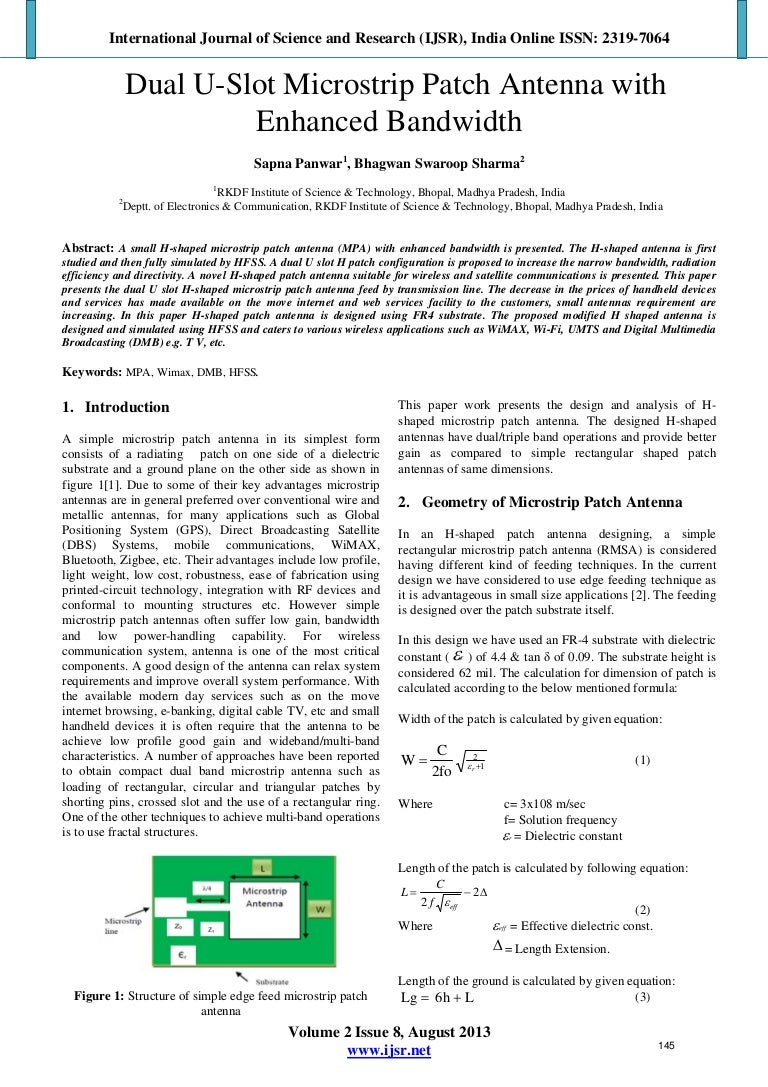U Slot Patch Antenna
U Slot Patch Antenna 8,9/10 4915 votes
Wireless local-area networks (WLANs) at 5 GHz offer the impressive data rates (54 Mb/s) that have helped them grow in popularity. The broad bandwidth of these systems—from 5.15 to 5.85 GHz—also poses a challenge for RF circuit and antenna designers. Fortunately, it is possible to cover the full 5-GHz band using a compact patch antenna.

Traditionally, patch antennas are limited in bandwidth, typically less than 5 percent. But numerous approaches have been developed to increase the bandwidth of a patch antenna, including the use of a U-shaped slot cut into the patch.1,2 A set of design equations has been derived for the purpose of determining the dimensions of the slot relative to the patch size, and these equations have shown good accuracy compared to measured results.2
Figure 1 shows an example of a wideband antenna with a U-shaped slot for 5-GHz use. The antenna patch is 1.719 in. long and 0.866 in. wide. With a height of only 3.5 mm, it is designed for low-profile applications, such as in computer WLAN cards. The patch antenna is fed with a probe near the patch's center. The slot, which is 0.022 in. wide, is cut symmetrically around the RF feed point. The antenna structure is extremely simple, yet offers good RF performance. Figure 2 shows the antenna's return loss, better than 10 dB. The plot shows that the antenna can easily cover a range of 5 to 6.5 GHz with its 26.5-percent bandwidth.
The addition of resonant modes helps to increase patch-antenna bandwidth. Once the multiple resonant points are created, they can be placed at optimized positions for good performance. In the design of Fig. 1, a total of two such resonant points is more than enough to achieve the bandwidth goals for 5-GHz WLAN operation. The total bandwidth and the depth of the combined resonance can be controlled by moving each of the two resonant points closer together or further apart. When the resonant points are closer, the bandwidth is smaller and antenna is better matched to 50 Ω. As the resonant points are spread further apart, the bandwidth increases but the antenna is less matched to 50 Ω.
- Define Parameters The basic U-slot patch antenna consists of a rectangular patch radiator within which a U-shaped slot has been cut out. As discussed in, the patch itself is on an air substrate and thick so as to enable higher bandwidths to be achieved.
- Patch antennas incorporating a U-shaped slot are well-known to have relatively large (about 30%) impedance bandwidths. This work uses characteristic mode analysis (CMA) to explain the impedance behavior of a classic U-slot patch.

Circularly polarized slot cut rectangular microstrip antenna on thinner substrate is proposed. The dimensions of the slots are modified such that the resonance frequencies of the two orthogonal. 5.5 The U-slot patch 5.6 The L-probe fed patch 3. The methods developed for efficient wideband patch antenna design are based on one or more of the following. The U-slot patch antenna, a single-layer single-patch antenna on a relatively thick substrate $(sim 0.08lambda 0)$, is a wide-band antenna with an impedance bandwidth in a range of 20%–30%.

The patch itself provides one resonant point. The U-shaped slot is another resonant point. The U-shaped slot essentially forces current to flow in a different path on the patch. Each path of current flow corresponds to a resonant point. Once the equivalent current-flow path is determined, it can be easily converted back to the resonant frequency based on its length. This is the basic theory behind this type of antenna. Figures 3 and 4 display the current flow at the two resonant points in the patch antenna. At 5.3 GHz, RF current flows up first, then returns to the feed point. At 6.3 GHz, RF current flows down first. Detailed derivation of the design equation is contained in ref. 2 and will not be repeated here. Since the design is an iterative process, it is possible to compile the design equations from ref. 2 into a MathCAD program. For clarity, the notation of that original reference has been followed here,2 with the MathCAD file shown in Fig. 5. All dimensions are in metric units.
The derived equations, developed by observing the RF current-flow paths on a patch antenna, were used as starting points for the U-shaped patch antenna design. Numerous rounds of simulations were performed for optimizing the design. For this optimization purpose, the IE3D three-dimensional (3D) electromagnetic (EM) simulation software from Zeland Software (Fremont, CA) was used in modeling the patch antenna. Each simulation run required about 20 minutes with good accuracy on a standard personal computer (PC).
The U-shaped patch antenna's radiation pattern is shown in Fig. 6, with the directional pattern typical of patch designs. Simulated maximum antenna gain is close to 9.5 dBi. Because of its compact size, generous bandwidth, and high gain, the U-shaped patch antenna is well suited for point-to-point applications in 5-GHz WLAN systems.

ACKNOWLEDGMENT
The author greatly appreciates the technical supports provided by Dr. Jiang-X Zheng of Zeland on IE3D software. IE3D is a trademark of Zeland Software. Mathcad is a registered trademark of MathSoft, Inc.
REFERENCES

U Slot Microstrip Patch Antenna
- T. Huynh and K.F. Lee, 'Single-layer single-patch wideband microstrip antenna,' Electronics Letters, Vol. 31, No. 16, August 3, 1995.
- R. Bhalla and L. Shafai, 'Resonance behavior of single U-Slot microstrip patch antenna,' Microwave and Optical Technology Letters, Vol. 32, No. 5, March 5, 2002.